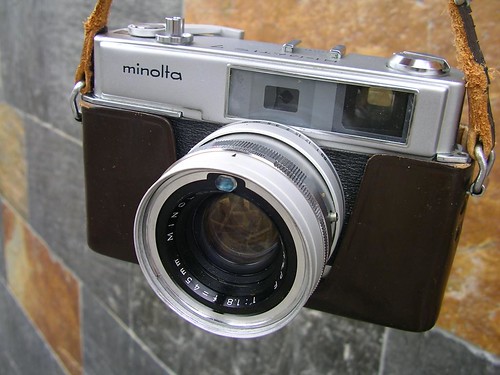Minolta Hi-Matic 7

|
| image by Uwe Kulick (Image rights) |
In 1963 the Minolta HI-MATIC 7 succeeded the original Minolta Hi-Matic 35mm rangefinder camera. It had new features, especially a CdS meter placed above the lens optics within the filter ring, a manual shutter speed selection mode, and the exposure meter's actual EV-value displayed in the viewfinder. Like the original Hi-Matic its viewfinder was a rangefinder with mechanical parallax correction, and it had a self-timer. With this camera Minolta made the "Hi-Matic" camera series their main series of range- and viewfinder cameras. Every Hi-Matic had auto-exposure, and increasing support for flash use.
The Hi-Matic 7s and Hi-Matic 9 followed in 1966, and were slightly improved versions of the 7. The 7s added a hot shoe and Safe Load System (SLS) indicator to show that film was being transported properly. The range finder windows changed from a contrasting 'pink and green' tint to 'yellow and blue'. The carrying strap lugs were moved up to the side and given a more rounded shape. The end of the lens barrel is black rather than the brushed aluminium of the 7. The 9 was the same as the 7s with the addition of a slightly faster f/1.7 lens, and an easy flash system, where the flash guide number was dialled into the lens, and the aperture was set automatically, according to the focus distance.
- Type: rangefinder camera
- Manufaturer: Minolta
- Year of release: 1963
- Films: 35mm films with speeds 25 to 800 ASA
- Lens: 6 lenses 1:1,8 f=45mm Rokkor
- Metering: CdS meter, EV 5.7 - EV 17
- Weight: 770 g
- Dimensions: 140×82×73mm
Pictures

|

|

|

|

|
|
Pictures of the Minolta Hi-Matic 7s with added hotshoe and CLC metering | ||||
Links
- Minolta Hi-Matic page in wikipedia
- Hi-Matic 7, Hi-Matic 7s, Hi-Matic 7s II on www.collection-appareils.fr by Sylvain Halgand
- Hi-Matic 7 in Minowiki [1]
- Minolta Hi-Matic 7s at My 35mm Film Camera Collection